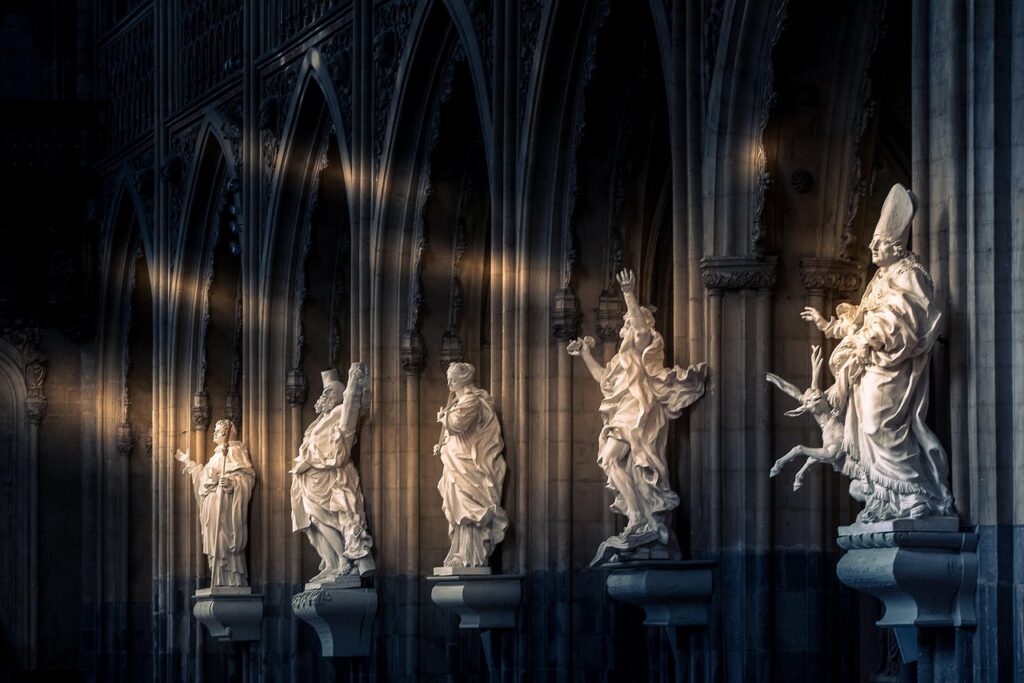
In February 2016, a Michigan-based priest, Gerald Johnson, experienced a life-altering event that, by his own account, transcended the boundaries of earthly existence. Following a heart attack, Johnson claims he underwent a near-death experience (NDE) unlike the commonly reported visions of warmth and light. Instead, he describes a harrowing journey into the depths of what he asserts to be hell, a place of indescribable torment and unsettling revelations.
His account, widely disseminated through viral videos, offers a stark contrast to many popularized NDE narratives, presenting a vivid, albeit disturbing, tableau of the underworld. Johnson’s testimony has ignited widespread discussion, not only among those interested in spiritual experiences but also within a broader public grappling with existential questions and the nature of life beyond the physical.
This article will meticulously explore Pastor Johnson’s extraordinary claims, dissecting the vivid details of his purported descent, the chilling sights and sounds he reported, and his initial interpretations of this profoundly traumatic encounter. We will examine his statements with the rigorous approach of journalistic inquiry, presenting his narrative as he has described it, and laying the groundwork for a deeper understanding of the implications of such a compelling, and for many, terrifying, personal experience.
1. **A Sudden Descent: Pastor Johnson’s Heart Attack and the Unforeseen Path**
The genesis of Pastor Gerald Johnson’s extraordinary claim traces back to a severe heart attack he suffered in February 2016. It was during this critical medical event, he states, that his spirit temporarily departed from his physical body. This separation marked the beginning of a journey he emphatically declares he “wouldn’t wish on my worst enemy.” The experience was immediate and profound, triggering a complete re-evaluation of his understanding of the afterlife.
Johnson, a man who had dedicated his life to spiritual service, initially believed his path after death would lead him upward, towards a heavenly realm. He reflected, “I thought I was going upward, because I thought that I had done so much good in this lifetime and helped so many people and made so many decisions that were Godly decisions.” This expectation, rooted in his faith and perceived good deeds, was dramatically subverted.
Instead of ascending, Johnson recounted a rapid descent. “But as opposed to me going up, I went down,” he explained. This unexpected trajectory immediately signaled a deviation from his preconceived notions of eternal reward, plunging him into an experience that would forever alter his perspective on spiritual accountability and the nature of divine judgment.

2. **The Earth’s Fiery Core: Locating Hell in Johnson’s Vision**
Pastor Johnson’s descent, he claimed, was not merely symbolic but geographical. He asserted that his spirit traveled “literally into the center of the Earth. That’s where Hell is.” This precise localization of the underworld provides a concrete, albeit terrifying, detail to his account, suggesting a physical dimension to the spiritual realm he visited. His description emphasizes a tangible, rather than purely abstract, experience of hell.
Upon entering what he describes as the fiery depths, Johnson found himself confronted with a reality far more horrifying than any theological text might convey. The initial shock of his location, in contradiction to his expectations of Heaven, underscored the profound gravity of his situation. This unexpected destination became the backdrop for the vivid and disturbing scenes that followed, leaving an indelible mark on his consciousness.
He recalled the experience with a sense of lingering awe and trauma, stating, “It just blew me away, it still baffles me to this day.” The sheer unexpectedness of being in this particular location, coupled with the immediate realization of its identity as hell, set the stage for the torment he was about to witness and endure, permanently altering his spiritual understanding.

3. **Witnessing Torment: The Horrifying Vision of a ‘Hellhound’**
Among the “indescribable things” Johnson claims he witnessed in hell, one particular vision stands out for its visceral horror: a man subjected to perpetual torment. He described seeing this individual “walking on all fours like a dog and getting burned from head to toe.” This image conveyed a profound sense of dehumanization and relentless suffering, a stark depiction of infernal punishment.
Further detailing this horrific sight, Johnson noted the man’s physical state: “His eyes were bulging and worse than that: He was wearing chains on his neck.” The chains were not merely restrictive; they were controlled by a demonic entity. “There was a demon holding the chains,” Johnson explained, presenting a chilling tableau of an enslaved soul tormented by its captor, likened to a ‘hellhound’.
Adding another layer of dread, Johnson recounted a form of telepathic understanding he gained during this observation. He discerned that “the demon was sent in this man’s life to ride him from his childhood to his death.” This suggested a premeditated, lifelong spiritual assault by the demon, designed to ensure the man’s damnation and subsequent servitude in hell. “This demon knew that ‘if I could stay in his life long enough on the earth, if I can keep getting him to not serve God and to make bad decisions on the earth, then I’ll have power over him in hell and he will be a slave to me’,” Johnson shared, highlighting the insidious long-term objective of the demonic entity.
4. **A Symphony of Suffering: Pop Music in the Underworld**
Beyond the gruesome physical torments, Pastor Johnson reported another profoundly unsettling aspect of hell: the presence of music. This was not the wailing or gnashing of teeth one might expect, but rather familiar melodies from Earth. He described a specific “section in Hell where music was playing.” This detail adds a bizarre, almost surreal, element to his account of the underworld.
The music, however, was not performed by human artists. Johnson clarified, “It was the same music we hear on the Earth, but opposed to entertainers singing it, demons were singing it.” This transformation of familiar tunes into instruments of torture, rendered by demonic voices, amplified the horror of the experience, turning sources of earthly pleasure into unending agony.
He reflected on the striking contrast between how music is perceived on Earth and its function in hell. “While up here, you can listen to music to get over a breakup like ‘Don’t Worry Be Happy’ or ‘Umbrella’, but down there every lyric to every song is to torment you.” This fundamental shift in purpose underscores the pervasive nature of suffering in the hellish realm he claims to have visited, where even cultural touchstones are weaponized.
5. **The Sounds of Agony: Rihanna’s ‘Umbrella’ and McFerrin’s ‘Don’t Worry, Be Happy’**
Among the repertoire of demonic renditions, Pastor Johnson specifically named two popular songs that haunted his experience: Rihanna’s hit single ‘Umbrella’ and Bobby McFerrin’s famously upbeat ‘Don’t Worry, Be Happy’. The choice of these particular tracks, known for their mainstream appeal and often positive associations, made their usage as tools of torment particularly chilling.
Johnson noted the profound irony of these songs being utilized in such a dark context. On Earth, ‘Umbrella’ often signifies protection and loyalty, while ‘Don’t Worry, Be Happy’ is an anthem of optimism. In hell, however, these meanings were grotesquely inverted, their lyrics twisted to exacerbate the suffering of the damned. “Every lyric to every song is there to torment you,” he emphasized, as the words echoed with a new, agonizing significance.
The torment, according to Johnson, stemmed from the fact that these songs served as a painful reminder of missed opportunities for worship. He suggested that the repetition of secular lyrics in hell was a constant indictment: “Every lyric, in every song is there to torment you as to the fact that you did not worship God through music when you were on the earth. You had the chance to worship Him at church or worship Him at home, but you chose to worship Satan by repeating the lyrics that he inspired to come into the earth.”
6. **Demonic Inspiration on Earth: The Source of Secular Music**
Pastor Johnson’s experience in hell led him to a startling conclusion about the origins of popular music on Earth. He claims that his vision revealed that many secular songs are not merely products of human creativity but are, in fact, inspired by malevolent forces. “I knew on earth that a lot of the lyrics and the music and the songs are inspired by demons,” he stated, a revelation he believes was solidified during his NDE.
According to Johnson, this demonic inspiration serves a specific, sinister purpose: control. He asserted, “People come into contact with demons who give them lyrics for the purpose of controlling people on Earth.” This claim posits that the seemingly innocuous act of listening to popular music could inadvertently align individuals with demonic influence, even if unknowingly.
The ultimate goal of this manipulation, Johnson concluded, is to ensure servitude, both in this life and the next. He warned, “It’s like you’re a slave on earth to the things of the devil and then in hell, you are a ‘tormented-dog’ slave.” This profound connection between earthly musical preferences and eternal damnation serves as a critical warning within his narrative, urging listeners to reconsider the spiritual implications of their entertainment choices.
His chilling testimony suggests that the battle for souls is waged not only in overt acts of faith or sin but also in the more subtle realms of culture and consciousness, where popular melodies become conduits for spiritual warfare. The insidious nature of this alleged demonic influence further highlights the pervasive and cunning tactics Johnson believes are at play in the world, leading individuals down a path that culminates in the torments he claims to have witnessed.

7. **The Theological Root: Unforgiveness and the Path to Perdition**
Pastor Johnson’s journey into the inferno presented him with a profound spiritual paradox, one that initially left him in a state of deep confusion and anger. Having dedicated his life to God, performing what he believed were countless good deeds and making godly decisions, he fully anticipated an ascent to heaven. The unexpected descent into hell challenged his fundamental understanding of divine justice and personal merit, sparking an intense internal conflict over his perceived fate.
It was in the aftermath of this harrowing experience, upon his return to consciousness, that Johnson claims to have received a divine revelation explaining the true cause of his hellish visitation. He realized that despite his outward acts of piety and service, a critical spiritual ailment festered within his heart: unforgiveness. This wasn’t a matter of insufficient good deeds, but rather a specific, deeply rooted emotional and spiritual blockage that, according to his account, contradicted the very essence of divine grace.
Johnson described being “secretly upset with the people who have hurt you.” This internal bitterness, he understood, was not merely a personal failing but a significant impediment to his spiritual standing. The concept of harboring resentment, hoping for divine retribution against those who had wronged him, placed him in a theological quandary, highlighting the distinction between outward religious observance and the inward state of the heart.
His chilling conclusion, derived from this self-analysis, was that “a person that can’t forgive is a person that has forgotten how much they have been forgiven of.” This insight points to a critical element of his theological framework: that individuals, through their unresolved spiritual issues, inadvertently choose their own eternal destination. According to Johnson, this internal spiritual state, rather than external divine decree, dictates whether one descends into hell.
8. **The Divine Intervention: God’s Message and a New Commission**
The moment of Pastor Johnson’s transition from the depths of hell back to earthly consciousness was, by his description, as abrupt as his initial descent. Lifted from the torment, he returned to his physical body with a consciousness profoundly altered by the indelible imprints of the underworld. This return was not merely a physical resuscitation but, for Johnson, the dawn of a new spiritual understanding, shaped by the divine communication he claims to have received.
Upon his reawakening, Johnson explicitly stated that he received a direct, personal message from Jesus Christ. This message underscored the root cause of his terrifying journey: his unresolved anger and resentment. Jesus reportedly confronted Johnson’s secret desire for punishment upon those who had wronged him, gently reminding him, “These are not your people. These are my people.” This statement served as a profound reorientation, shifting Johnson’s perspective from personal grievance to a broader, divine compassion.
The divine interaction culminated in a clear directive for Johnson’s future: “I only want you to focus on the assignment I am giving you.” This was not merely a call to continue his ministry but a specific, re-calibrated purpose, emphasizing forgiveness and the unique work God intended for him. It represented a fundamental shift from dwelling on past hurts and personal anger to embracing a forward-looking, divinely appointed mission.
This transformative encounter instilled in Johnson a renewed sense of purpose and profound gratitude. He declared, “I thank God for the Light, who is Jesus. Because of that Light, I will not see any more days in hell.” His experience, therefore, evolved from a narrative of torment into one of profound redemption, emphasizing the salvific power of forgiveness and the guidance he claims to have received from a higher authority.
9. **A Solemn Warning: Johnson’s Call to Repentance and Reflection**
Returning from what he describes as the real hell, Pastor Johnson has taken on the mantle of a spiritual messenger, broadcasting a stark and urgent warning to the world. His message, widely disseminated through viral accounts, emphasizes that hell is not a mythical construct but a tangible, terrifying reality. This isn’t merely a personal anecdote; it’s presented as a universal caution, intended to provoke deep introspection and spiritual preparedness in all who hear it.
A central tenet of Johnson’s warning is his firm belief that individuals, not God, ultimately determine their eternal fate. He asserts, “God doesn’t send people to Hell, people send themselves to Hell.” This perspective places significant spiritual agency on humanity, suggesting that unaddressed internal conditions, rather than divine decree, chart one’s course toward either salvation or damnation.
Johnson elaborates that the unresolved issues one carries throughout life and into death are the determinants of one’s spiritual destination. He challenges individuals to consider, “Whatever is still left inside of you that God has been trying to get out of you that you die with that is going to determine where you go.” The core questions, he emphasizes, revolve around one’s capacity for love and forgiveness—fundamental virtues in his theological framework.
His message resonates with an urgent spiritual directive, a clear call to introspection and correction of the heart. By sharing the horrors he claims to have witnessed and the divine message he says he received, Johnson implores listeners to confront their inner spiritual state, rectify any lingering unforgiveness, and cultivate a heart aligned with divine principles before it is, in his view, too late.
10. **Beyond the Veil: Negative Near-Death Experiences in Context**
Pastor Johnson’s account stands in stark contrast to many widely popularized near-death experience (NDE) narratives, which frequently describe visions of warmth, light, and overwhelming peace. His traumatic descent into hell, characterized by tormenting demons and a profound sense of despair, highlights the diverse and often unsettling spectrum of reported NDEs. It underscores that encounters at the precipice of death are not universally beatific but can encompass terrifying and profoundly negative dimensions.
Indeed, Johnson’s experience is not an isolated anomaly within the broader study of NDEs. Researchers, particularly those associated with organizations like the International Association for Near-Death Studies, acknowledge the occurrence of negative NDEs. While less frequently publicized, these harrowing accounts form a significant, albeit challenging, subset of near-death phenomena, indicating that not all voyages beyond the physical body are perceived as comforting or benevolent.
These negative experiences, whether described as encounters with hellish realms, overwhelming loneliness, or terrifying voids, often leave an equally profound and lasting impact on the individuals who report them. Much like Johnson, those who undergo traumatic NDEs frequently find their worldviews irrevocably altered, their priorities dramatically shifted, and their spiritual or philosophical perspectives fundamentally reshaped by the encounter. While some may struggle to recount such distressing memories, the transformative power of these experiences remains a consistent theme, regardless of their perceived valence.

11. **The Scientific Lens: Exploring the Physiology of Near-Death Experiences**
While Pastor Johnson’s narrative is deeply rooted in spiritual and theological interpretations, scientific inquiry offers a complementary, albeit distinct, perspective on the phenomenon of near-death experiences. Researchers, including those affiliated with the International Association for Near-Death Studies, hypothesize that NDEs are most likely a complex physiological response to sudden, life-threatening events. These events can range from heart attacks, as in Johnson’s case, to blunt trauma or severe shock, which drastically alter the body’s normal functions.
A leading theory centers on the critical role of blood flow and oxygen supply to the brain during such crises. As the body teeters on the brink of collapse, the brain’s access to vital oxygenated blood is severely compromised. This deprivation is believed to trigger a cascade of neurobiological events that could account for the vivid and often elaborate sensations reported during NDEs, suggesting a deeply physical basis for these seemingly transcendent experiences.
As the brain loses its essential supply of blood and oxygen, its intricate electrical activity begins a gradual shutdown process. One expert vividly described this phenomenon to Scientific American, likening it to “a town that loses power one neighborhood at a time, local regions of the brain go offline one after another.” This sequential deactivation of brain regions could potentially lead to altered states of consciousness, sensory distortions, and the hallucinatory experiences commonly reported during NDEs, including feelings of detachment or panoramic life reviews.
Under this scientific framework, the mind, though severely challenged, continues to function but without its normal operational parameters. Whether these experiences are the result of an acute oxygen shortage, the effects of certain anesthetics, or a specific neurochemical response to trauma, the physiological explanations seek to ground NDEs within the measurable and observable functions of the human brain. This approach, while not discrediting individual spiritual interpretations, provides a framework for understanding the biological underpinnings of such profound subjective experiences.
12. **Memory and Transformation: The Enduring Impact of Near-Death Experiences**
Regardless of whether one interprets Pastor Johnson’s account through a spiritual or a purely scientific lens, there is universal agreement on one critical aspect: near-death experiences, whether blissful or terrifying, leave an indelible mark. Researchers acknowledge that NDEs result in “a real, sometimes traumatic memory” for those who undergo them. These memories, often exceptionally vivid and emotionally charged, can feel more real than ordinary waking life, fundamentally altering an individual’s perception of reality and existence.
The profound impact of such an experience frequently transcends its origin, whether it is seen as a divine encounter or a neurophysiological event. For many, an NDE serves as a catalyst for deep personal transformation. It can lead to significant shifts in values, a heightened sense of spirituality, a diminished fear of death, and a renewed appreciation for life. As noted, for individuals like Johnson, it “could change their life,” driving them to re-evaluate priorities and dedicate themselves to a new purpose.
Yet, even with scientific hypotheses offering potential explanations for the mechanics of NDEs, the ultimate questions they raise often remain unanswered. The personal meaning and existential implications derived from these experiences continue to challenge both scientific and theological paradigms, pushing the boundaries of our understanding of consciousness, the human brain, and the potential for existence beyond what we currently comprehend.
Pastor Gerald Johnson’s extraordinary account of his journey to hell stands as a potent example of this enduring mystery. His testimony, whether viewed as a literal spiritual visitation or a profound psychological event, undeniably speaks to the human capacity for intense subjective experience and the inherent quest for meaning in the face of death. It forces us to confront not only the possibility of an afterlife but also the profound, life-altering impact that moments at the threshold of existence can have, prompting ongoing reflection on what truly lies beyond the veil of life as we know it.










